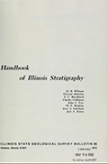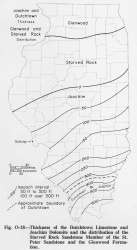Historical:Dutchtown Limestone
Lithostratigraphy: Ottawa Limestone Megagroup >>Ancell Group >>Dutchtown Limestone
Chronostratigraphy: Paleozoic Erathem >>Ordovician System >>Champlainian Series >>Blackriveran Stage
Allostratigraphy: Tippecanoe Sequence
Authors
H. B. Willman and T. C. Buschbach
Name Origin
The Dutchtown Limestone (McQueen, 1937, p. 12) is named for Dutchtown, Cape Girardeau County, Missouri.
Type Section
The type section of the Dutchtown Limestone Formation is in a bluff 1 mile east of Dutchtown.
Correlation
The Dutchtown Limestone is correlated with similar dark limestone in the Murfreesboro Limestone in Tennessee and the Pamelia Limestone in New York.
Extent and Thickness
The Dutchtown Limestone is not exposed in Illinois, but it has been penetrated in wells as far north as southern Jackson County, thinning in that direction from a known thickness of about 150 feet in the Cape Girardeau area (fig. O-18). However, drilling near by in Kentucky suggests it is as much as 200 feet thick in southeastern Illinois (DuBois, 1945; Templeton and Willman, 1963).
Stratigraphic Position
The Dutchtown Limestone overlies the St. Peter Sandstone and underlies the Joachim Dolomite in extreme southern Illinois (fig. O-18). It is differentiated into two members, the Gordonville below (largely dolomite) and the Sharpsboro above (largely limestone). It appears to grade laterally into the St. Peter Sandstone.
Description
The Dutchtown is largely dark gray (nearly black), argillaceous, lithographic limestone and dolomite. When freshly broken it has a strongly fetid odor. It contains beds of gray and brown shaly limestone and dolomite, calcareous siltstone, and dolomitic sandstone. Its dark color and prevalence of limestone differentiates it from the overlying Joachim Dolomite.
Fossils
The Dutchtown is fossiliferous, and mollusks, ostracodes, and conodonts are the most abundant fossils.
References
DUBOIS, E. P., 1945, I. Subsurface relations of the Maquoketa and "Trenton" Formations in Illinois: Illinois State Geological Survey Report of Investigations 105, p. 7-33.
MCQUEEN, H. S., 1937, Dutchtown, a new Lower Ordovician formation in southeastern Missouri: Missouri Geological Survey and Water Resources, 59th Biennial Report, 1935-1936, app. 1 , 27 p.
TEMPLETON, J. S., and H. B. WILLMAN, 1963, Champlainian Series (Middle Ordovician) in Illinois: Illinois State Geological Survey Bulletin 89, 260 p.
ISGS Codes
| Stratigraphic Code | Geo Unit Designation |
|---|---|

